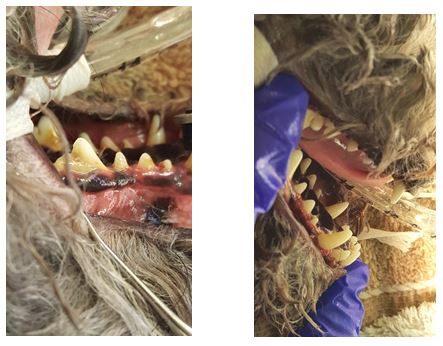posted by Jeremy Karns on Wednesday, February 1, 2017 in From the Mailbox of Dr. M
For those unaware, February is National Pet Dental Health Month. In the hustle and bustle of life, we often find ourselves losing track of our own appointments and general preventative health needs, let alone remembering to take care of our animal’s oral health. One thing many pet owners are not aware of is routine dental exams play an important part in maintaining a healthy animal.
Periodontal disease is the number one cause of dental disease in animals. Periodontal disease can be scored in 4 stages. Stage 1 is classified by a slight amount of visible tartar on the teeth and the gums may have slight swelling and/or redness to the gums. When we move to stage 2 and 3, there is much more visible tartar, and an even larger increase in redness and gum swelling. What differentiates stage 2 from stage 3 is the bone destruction that can be evidenced on dental radiographs in stage 3. During stage 4, there is severe plaque and tartar accumulation, tooth loss, evidenced gum recession and root exposure, as well as, possible pockets of infection visible.
The next question many people ask is how this staging may impact the overall health of their animal. The culprit behind periodontal disease is bacteria; a lot of it. Bacteria sneak in and accumulate through day to day activities and eating habits of our pets. With time, these bacteria will damage enamel and ligaments, as well as, gums making for unhealthy and unstable teeth. Besides the problems that may happen with the teeth themselves, when bacteria become heavy there is also the threat to an animal’s bloodstream when tartar breaks off. Once in the bloodstream, an animal can develop kidney problems, cardiac problems, and even sepsis and death.
So what exactly is involved in a dental cleaning for a pet? Unfortunately, I do not know many (though there are a few!) animals that will willingly sit and let you clean their teeth twice a day to help prevent accumulation of plaque and tartar. Nor will they sit and say “ahhh,” to allow us to scale and polish teeth once a year either. The next option is to carefully sedate your animal to allow a comfortable, thorough cleaning and examination of the oral cavity. This allows us to assess overall health, and check for any masses or concerns that need addressing. For my dentals, I require all animals to be placed on an anesthetic machine that allows us to monitor their breathing, protect their airway, and dictate the amount of gas they are receiving. During the procedure, our dental tools (much similar to those your dentist has) are used to remove built up plaque and tartar. Then we use a polisher and apply a polish that helps protect the enamel on the teeth. Your pet is then administered an antibiotic and pain medication as standard precaution and comfort. I send all dentals home on an antibiotic, to aid as another way to help prevent problems from the plaque and tartar removal. Besides cleaner looking teeth, the most noticeable improvement is the lack of foul smelling breath their animal may have had prior to surgery. Below is an example of before and after tartar and plaque removal in one of my patients, the difference is quite noticeable!

Outside of routine dentals, there are preventative measures owners can take at home to help deter the accumulation of plaque and tartar. There are different chews/treats and food available, but I caution my clients to adhere to the AVMA (American Veterinary Medical Association) recommendations before purchasing a product that claims to be a dental product. I would be happy to discuss what products we carry here at the clinic, and the mechanism behind which they work. Additionally, we are running a special during the next month, where any dental cleaning appointment made during the month of February will receive a discount. Please call the clinic to schedule this great opportunity!
I wish you all a safe and warm February.
Tags
- dental
- health
- pet dental month